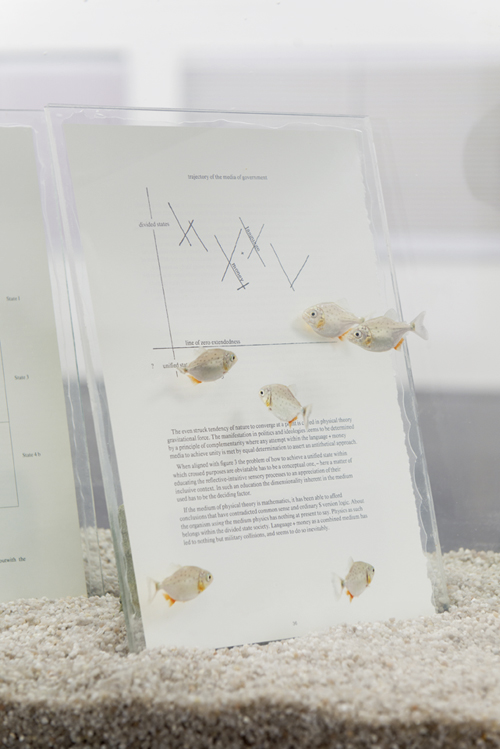Waste, Not.
Galerie Gregor Staiger
Galerie Gregor Staiger

A slew of gallery exhibitions opening in Zurich at the end of the summer contained the kind of expensively fabricated, high gloss, inoffensive art that seems made for corporate collections. And then, in contrast, there was Waste, Not., curated by artist Matthew Richardson, which needled at the criteria of value and standards for art production that the other shows were promoting. The exhibition title cut short the usual maxim (‘waste not, want not’), turning it into elliptical teenage sarcasm and inviting the viewer to consider if the works on show held worth or could, indeed, be superfluous.
The show brought together works by six British artists: Rachal Bradley, Timothy Davies, John Latham, Patricia Lennox-Boyd, Hannah Sawtell and Richardson himself. The first work the visitor met was Latham’s They’re learning fast (1988/2013), a fish tank in which young piranhas swim around four reprinted pages from Latham’s Report of a Surveyor, published in 1984. Of course the fish were not getting any wiser, in fact in their juvenile state they just seemed petrified by their surroundings, and Latham’s frustration – to communicate the ideas in his work he put them in black and white and still they were not taken up, so fish might be more receptive – could be sensed as keenly as ever. Richardson’s two sculptures in the show were equally futile and tongue in cheek. Self employed II and CV Clinic (both 2012) are small cubic steel units placed on the floor, the top and one side of each open, and both containing twin rollers; the latter, biscuit-coloured work also includes a replica cracker tucked tidily in one corner. Even though their titles are in the language of go-getting capitalist efficiency and they intimate utility, a service they could provide – printing or shoe polishing, say – they are quite evidently useless.

Richardson compared the impotence of these male enterprises with Lennox-Boyd’s satirical fertility: Ovum (ooplasm) (2013) consists of six photographs, radiating yellow, of an egg yolk being separated; these were pinned to the wall behind a clear resin conduit threaded with a white extension cable. The yolks may suggest potential life, but they are unfertilized – the avian embryo winding up, perhaps, as human breakfast – while, unused, the cable carried only enough current to keep an LED illuminated. Bradley’s works, on the other hand, were gendered in a no-nonsense fashion; four 2012 pieces from her Out of Season series are photographs of Bridget Riley paintings from catalogues – where the artist chooses to present them reproduced as vectorized drawings – with a nurse’s watch pinned in the general top right of the landscape-oriented works. Sawtell’s Mole (2009–13) stood between Bradley’s images as if trying to be overlooked, a steel column lacquered green, with a light bulb at its head illuminating the wall behind. The work was a spy in the anarchic ranks, an interloper from the neighbouring world of dry formalism, of art to be seen and not heard. For Waste, Not. was chaotic but thoughtful, an exhibition that toyed with several ideas: of the artist as worker in a system; of reproduction to the point where an original is no longer necessary (Dolly the cloned sheep being the image on the invitation) and of art’s own obsolescence. Several of these works play at leaning into a mercantile art world, but hide true trouble-making colours. In so doing, the exhibition skewered the complacency of several concurrent neighbouring galleries whose new season shows favoured size and shine over criticality, reclaiming the gallery as a site for uncertainty and contradictions.














